Photo Stories
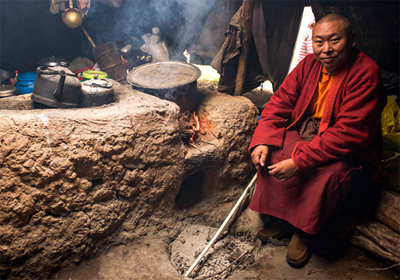
A brief introduction to "Portraits of Tibet".
My nomadic roots trace back to the 70s as a hippie living in a camper van in America, and at age 25 I met my first Tibetans, when the 16th Karmapa and his entourage visited Wales.
Later I became immersed in Tibetan lay and monastic communities in India and Nepal in the 1990s and was deeply moved by a culture that placed Spirituality at the heart of life. I began photographing the culture in exile for a small photo Library dedicated to Tibetan life inside and outside Tibet. I could not have imagined where this would lead me.
Click on the image above to read the full story on the KOSMOS COMMUNITY website.
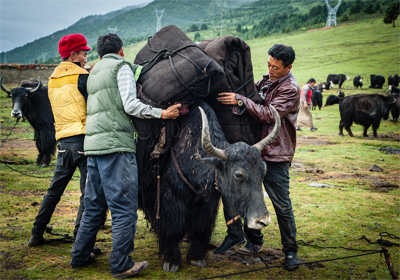
The People Working to Maintain Their Traditional Nomadic Way of Life
Tibet's Drokpa, or nomads, have been herding livestock on the vast high-altitude pastures of the Tibetan Plateau for millennia.
Traditionally, Tibetan nomads were very free, but recently, a lack of appreciation for and understanding of the indigenous knowledge of the Drokpa has resulted in the rapid erosion of this ancient way of life.
This essay explores the lives of four Drokpa communities holding the thread of tradition in the midst of modernization and imposing development.
Click on the image above to read the full story on the EMERGENCE website.

DROKPA: The Nomadic Mountain People of Tibet
I have been photographing Tibetans for a number of years—deeply inspired by a culture that places spirituality at the heart of life. I have been most moved by Tibet's Drokpa, or nomads, who until recently comprised an estimated 25 percent to 40 percent of the Tibetan population. Drokpa means, "people of the solitudes," and they are truly a mountain people, herding livestock on vast high-altitude pastures for millennia. Their way of life has remained unchanged for centuries, making them natural stewards of Tibet's grasslands and living examples of original Tibetan culture.
Click on the image above to read the full story on the Global Oneness Project website.
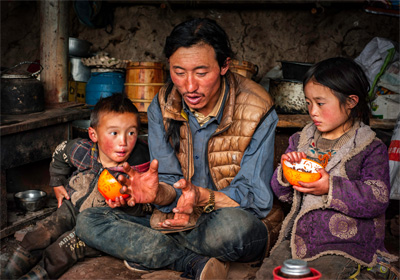
Dragons, Drokpa and a Drukpa Kargyu Master
The Role of Dragons in Tibet
In the West, dragons are the stuff of myth, legend and wonderful children's stories. But to Tibetan nomads, or "drokpa", dragons are real and seeing them is always an auspicious sign.
While travelling in eastern Tibet I visited Sonam Wangbo and his family, nomads who live in the remote, beautiful and sacred Dahu Valley. We travelled on horseback to his spring home high in flower-filled pastures and, settled in front of his stove with the Tibetan staple, a bowl of tsampa, I found myself asking him if he had ever seen a dragon.
Click on the image above to read the full story on the MOOWON website.
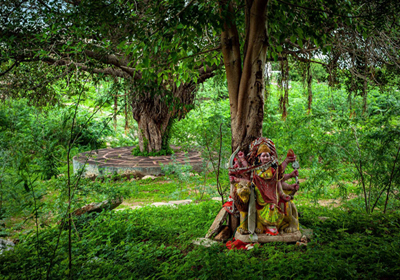
By Chelsea Steinauer Scudder
When a marble mine began to strip a village of its forests, the people of Piplantri, India, developed a tree-planting project that reclaims a vital and ancient relationship between trees and women.
This compelling story is told by Chelsea Steinauer Scudder, with images provided by Diane Barker.
Click on the image above to read the full story on the EMERGENCE website.
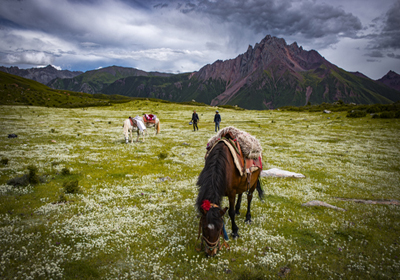
Buddhistdoor Global
Few outsiders to the Tibet-Qinghai Plateau have had the same access as Diane Barker, who has moved in diverse circles across Asia since the 1990s.
This article looks at her focus on the drokpa, which translates roughly to "people of the solitudes." These nomadic communities embody the oldest traditions of life in this remote region: patterns of herding, horsemanship, and kinship bonds that date well into the earliest periods of Tibetan history.
Click on the image above to read the full story on the BUDDHISTDOOR GLOBAL website.
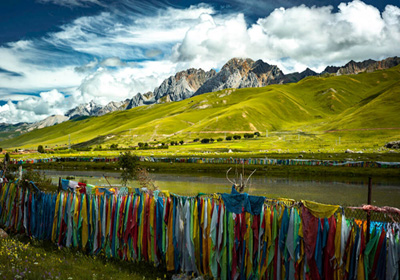
The Spritual Ecology of Tibetan Nomads
One Earth Sangha
Tibetan nomads have a way of life that is a model of ecological balance and sustainability, but they are being forced to adapt to challenges of government resettlement policies, global consumer culture, and climate change.
Author Raymond Lam describes photojournalist Diane Barker's exploration of the lives of Tibet's nomadic drokpa, "people of the solitudes," living on the remote Tibet-Qinghai Plateau.
Click on the image above to read the full story on the ONE EARTH SANGHA website.

The Understory by Robert Macfarlane
The story comes from a chapter of Robert Macfarlane's recent book "Underland: A Deep Time Journey" with photos of Epping Forest taken by Diane Barker, commissioned by Emergence to accompany the chapter in the magazine.
Click on the image above to read the full story on the EMERGENCE website.
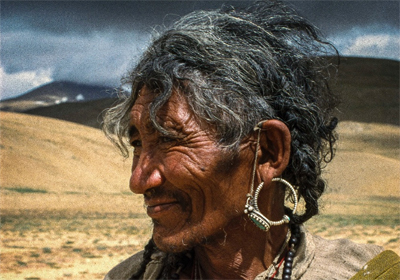
Earth Love Newsletter interview with Diane - Part 1
Raphael Block
Poet Raphael Block interviewed Diane Barker in December 2022, during which Diane described an ancient Tibetan ritual called the Mamos Puja, which is used to help keep society in harmony with the natural world.
Diane also talks about her early years as a painter and then photographer, and how an encounter with Tibetan nomads in Ladakh inspired her subsequent photographic work.
Click on the image above to read the full story on Raphael Block's website.
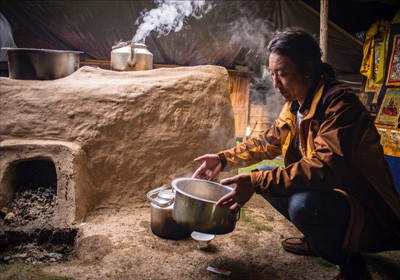
Earth Love Newsletter interview with Diane - Part 2
Raphael Block
Here Raphael continues his discussion of his interview with Diane back in 2022. In this session Diane describes several of her trips to Tibet, and her encounters, and bonding, with the nomadic communities.
Diane also discusses her book "Portraits of Tibet", and the role that her visits played in its development.
Click on the image above to read the full story on Raphael Block's website.
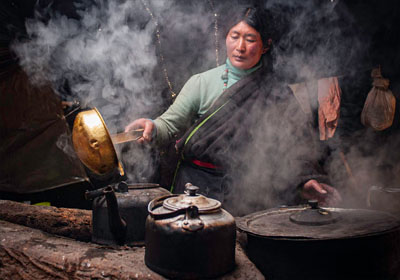
The Soul of the Drokpa Nomads of Eastern Tibet
Tibet is well known as "a land of snows," having the youngest and therefore some of the highest mountains on Earth. I found a landscape of awesome beauty, with an average altitude of 14,000 feet and an extreme, savage climate. It struck me that it takes a tough and resilient people to flourish in these conditions.
Perhaps the vastness and solitude of the landscape have been a source of inspiration for the Tibetans, helping to encourage their natural bent to visionary mysticism and to develop their unique brand of Buddhism.
Click on the image above to read the full story on the MOOWON website.

Spirits, Rituals and Festivals of the Drokpas
Sacred People. Sacred Place
Tibet is a sacred land, its people an expression of that sacredness. For 17,000 years before Buddhism arrived the nomads and farmers of Tibet practiced Bon Shamanism which revered the land and related to it as a spiritual being. The sky, mountains, rivers and lakes were animated by gods, demons or nature spirits.
The establishment of Buddhism in Tibet in the 7th century transformed the country and created a culture of tremendous depth and richness. Today, shamanic practices continue to coexist alongside studious monasticism and a lived compassion for all beings.
Click on the image above to read the full story on the MOOWON website.
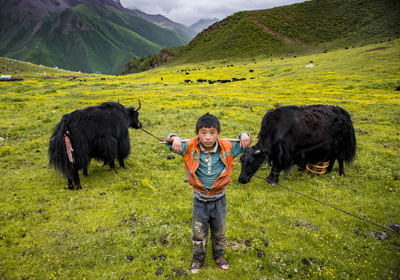
Guardians of the Sacred in Tibet
The Sacred Land of Drokpa Nomads
How is the worldview of Tibetan nomads (and other indigenous peoples) so relevant for the world today?
"Nomads believe that a person's life force is connected with a locality and the spirits that dwell there and that a deterioration of this bond can have negative repercussions." (From Drokpa: Nomads of the Tibetan Plateau and Himalaya by Daniel J Miller)
The Tibetan nomad's understanding of the sacred landscape brings reverence, care, and respect to the land, which is the basis of the conservation and environmental protection that the earth so badly needs today.
Click on the image above to read the full story on the KOSMOS website.
